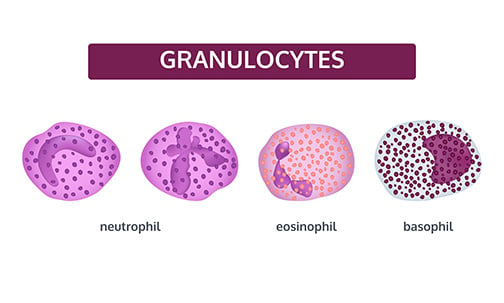Granulocytes

Granulocytes are white blood cells characterized by a lobed nucleus and cytoplasmic granules that contain cytolytic enzymes. They are the most abundant leukocytes and play a key role in the body’s first line of defense against bacteria and fungi, through the innate immune response. As well as attacking pathogens directly, recent research has shown that granulocytes also help to regulate the activity of the immune system through the release of effector molecules such as cytokines, histamine, chemokines, enzymes, and other growth factors.1,2,3 Some granulocytes, particularly neutrophils, have been shown to contribute to tissue repair.4
All granulocytes – including basophils, neutrophils, and eosinophils – develop from the myeloid lineage of hematopoietic stem cells in the bone marrow, driven by IL-3, IL-5, and G-CSF. A differential blood count is used to determine the number of each type of granulocyte in the blood, and granulocytopenia makes the body more prone to infections.
Find out more on each cell, including formation, function, emerging research, the best investigative methods, and common cell markers:
References
1. Tecchio C, Micheletti A et al (2014). Neutrophil-derived cytokines: facts beyond expression. Front Immunol 5:508. doi:10.3389/fimmu.2014.00508
2. Chirumbolo S, Bjørklund G, et al (2018). The role of basophils as innate immune regulatory cells in allergy and immunotherapy. Hum Vaccin Immunother, 14(4), 815–831. https://doi.org/10.1080/21645515.2017.1417711.
3. McBrien C, McBrien A (2017) The Biology of Eosinophils and Their Role in Asthma. Front Med 4:93 doi:10.3389/fmed.2017.00093
4. Peiseler M, Kubes P (2019) More friend than foe: the emerging role of neutrophils in tissue repair. J Clin Invest. 129(7):2629-2639. doi:10.1172/JCI124616

